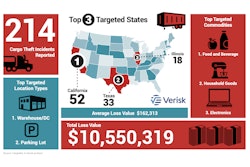 A few small changes can lead to a much healthier lifestyle
A few small changes can lead to a much healthier lifestyle
For some, the sheer thought of trying to lose weight can seem overwhelming. But, according to dietitian Sara Wilson, it doesn’t have to be.
“There are two things to really remember when eating, especially on the road,” says Wilson, a nutrition information specialist for the United States Department of Agriculture’s Food and Nutrition Information Center. “The first is to look at your food choices, and the second is to look at your portion sizes.” Wilson says the USDA has provided a few basic guidelines as far as specifics of what to eat daily (see “Your Food Pyramid”).
It’s important to remember that reaching a weight-loss or health goal “doesn’t have to happen overnight,” Wilson says. “I think a healthy diet is achievable for everyone, and it takes simple steps that you can work into your daily life.” For example, Wilson recommends stocking up on healthy food options that can easily be taken on the road, such as fruits and vegetables that can be cut into small pieces; trail mix, which is filling and “can be eaten throughout the day as a snack”; and things like yogurt, milk and fruit juice if you have a refrigerator available.
Wilson also says if you have problems eating healthy at restaurants or truckstops, take baby steps, like getting your sandwich on whole grain or wheat bread instead of white, choosing a healthy side like yogurt or apple slices (an option now available even in multiple fast-food restaurants) or getting cheese and condiments on the side so you can control the portions yourself.
In addition to healthy eating, physical activity plays a huge role in weight loss and living healthy. The U.S. Department of Health and Human Services, in its 2008 Physical Activity Guidelines, recommends adults get at least 2.5 hours of aerobic activity per week and that they perform strengthening exercises (like push-ups, sit-ups or lifting weights) twice each week. On the road, this might translate into taking a 30-minute walk at the truckstop five times a week or carrying weights in your cab that you can utilize on a stopover every few days.
Altogether, a healthier lifestyle is attainable, and it may not be as hard to reach your goals as you think.
Fast-food options
Lower-calorie options from several national fast-food chains
McDonald’s
Premium Grilled Chicken Classic Sandwich without mayo
370 calories, 4.5 g fat
Grilled Chicken Snack Wrap with Honey Mustard
260 calories, 9 g fat
Burger King
Bacon Cheeseburger
360 calories, 18 g fat
TENDERGRILL Chicken Sandwich without sauce
400 calories, 7 g fat
Taco Bell
Crunchy Taco: Fresco Style
150 calories, 7 g fat
Ranchero Chicken Soft Taco: Fresco Style
170 calories, 4 g fat
For more, visit www.fit4theroad.com
YOUR FOOD PYRAMID
Make half your grains whole: Eat at least 3 oz. of whole grain bread, cereal, crackers, rice or pasta every day.
Vary your vegetables: Strive to eat more dark green and orange veggies, as well as dry beans and peas.
Focus on fruits: Eat a variety of fresh, frozen, canned or dried fruits, but limit intake of fruit juice.
Milk-y way: Go low- or fat-free with dairy products or choose calcium-rich lactose-free products.
Protein power: Choose low-fat or lean meat and poultry, and bake, broil or grill it. Vary protein choices with more fish, nuts, peas, beans and seeds.
Information from www.mypyramid.gov
You Can Do This
Weight loss is not out of reach if you do it the right way
 Misty Bell is managing editor for Truckers News. You can find her health blog at www.fit4theroad.com. Contact her at [email protected] or http://twitter.com/fitfortheroad.
Misty Bell is managing editor for Truckers News. You can find her health blog at www.fit4theroad.com. Contact her at [email protected] or http://twitter.com/fitfortheroad.
They say slow and steady wins the race, and this is certainly true when it comes to weight loss.
With shows like NBC’s “The Biggest Loser” and VH1’s “Celebrity Fit Club” showcasing fat folks losing massive amounts of weight at lightning speed, it’s tempting to think shedding pounds should be a quick and easy process.
Former “Biggest Loser” contestant Ryan C. Benson made headlines in late November by revealing that he has gained back nearly all of the 122 pounds he lost while on the show, putting him back in the 300-lb. range. He contends that he used dangerous methods to lose weight at a rapid pace during the show, including intentionally dehydrating himself and skipping meals. Obviously weight loss can be quick, but given the medical problems you can cause yourself by going on crazy diets, it almost assuredly will not be worth it.
Losing only a couple of pounds per week, especially when you have a sizeable amount of weight to lose, can be frustrating, but one to two pounds per week is the amount recommended by the Mayo Clinic. Losing at this rate ensures that, once you have reached your goal weight, you have a good chance of maintaining that weight rather than gaining it all back.
As a trucker trying to lose weight, you face more difficulties than the average “loser”: You are on the road a lot, often have to eat whatever is available quickly, rarely have access to exercise equipment and work at a job that primarily involves just sitting and driving. But with ever-tightening FMCSA regulations on BMI and health conditions that are possibly connected to weight, it’s better to face these challenges now rather than when you are looking at losing your CDL.
That’s where we come in. Truckers News wants to see our readers succeed in becoming healthier, and we want to provide tools for you to do it. January marks the kick-off of our Take a Load Off weight-loss campaign. We also are launching Fit4theRoad.com, which will be a comprehensive, interactive website with information on health and weight loss, videos and other resources. You can visit the Fit for the Road site to sign up to Take a Load Off and get updates.
We will also provide opportunities for you to share your stories with us. We want to hear about your successes and your struggles, what works for you and what doesn’t. We plan to keep a running total of the amount of weight our readers lose during 2010 and post a grand total at the end of the year. And we’ll be offering some special events for Take a Load Off participants, so keep reading.
Here’s hoping for a healthier 2010. Good luck.
HEALTH RESOURCES
The United States Department of Agriculture lays out the specifics of healthy eating at www.mypyramid.gov. Here you can find information on the proper daily portions to eat of different types of foods, as well as a menu planner and dietary information tracking tool.
USDA provides information on nutrition and weight loss at www.nutrition.gov. The site includes a tool to search for the amount of calories in different types of foods.
For information on eating healthy at restaurants in the U.S., visit the Food and Nutrition Information Center Consumer Corner, www.fnic.nal.usda.gov/consumer. The site also includes “Do It Yourself” tools for calculating BMI, planning meals and calculating portion sizes.
The U.S. Department of Health and Human Services provides guidelines for healthy amounts of physical activity at www.health.gov/paguidelines. The site offers ideas for finding physical activities that best fit your lifestyle.








